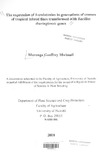| dc.description.abstract | Maize (Zea mays L.) is the third most important cereal grain globally, after wheat and
rice, and a significant contributor of food, feed and industrial uses. Infestation and
damage by the spotted stem borer, Chilo partellus (Swinhoe) and other stem borer species
in Kenya is a major constraint in maize production. The use of genetic engineering tools
for control of to C. partellus that utilizes genes derived from Bacillus thuringiensis (Bt)
(Berliner), that has been used successfully in other countries has been proposed for
Kenya. This study was carried out to determine the differences in the levels of CrylAb
protein (Bt 8-endotoxins) expression among the parental maize lines transformed using Bt
genes carrying events 216 and 223 and the parental non-transformed maize inbred lines
CML144 and CML159 and their F, and F2:3 generations. The crosses involved tropical Bt
and non-Bt maize inbred lines. The responses to the control of C. partellus were done
using insect bioassays, while the levels of expression of Bt 8-endotoxins among the
generations were done using enzyme linked immunosorbent assays (ELISA) and other
molecular methods. Bt maize lines carrying events 216 and 223 and non-Bt maize inbred
lines CML144 and CML159 were used to form the respective generations. The parental
lines, F, and F2:3 generations were evaluated using; (a) whole plant-insect bioassays to
determine the foliar damage ratings, plant height, ear height, number of exit holes,
cumulative stem tunnel length, number of larvae recovered, and number of pupae
recovered after infestation with C. partellus larvae, (b) differences in the levels of Bt 8-
endotoxins expression using dot blot analysis to confirm their presence or absence, and c)
enzyme linked immunosorbent assays (ELISA) to quantify the Bt 8-endotoxins in leaf
tissue. The treatments consisted parents, their F, and F2:3 crosses, and four checks. These
were replicated 4 times in a 15 x 5 alpha lattice design with each plot containing 4 plants.
The analysis of variance was carried out using PROC GLM of SAS (SAS, 2003) program
and the LSD was used for the separation of means.
There were significant differences (p<0.05) among resistant inbred lines (maize lines
transformed using Bt genes carrying events 216 and 223) and susceptible inbred lines
(CML144, CML159, CML216 and MBR), and the susceptible hybrid lines (CKIR6009
and H513) for foliar damage, number of exit holes, cumulative stem tunnel length,
number exit holes, ratio of tunnel length to stem length, and number of larvae recovered
and number of pupae recovered. No significant differences (p<0.15) were observed
among parents, FI, and F3 generations of the crosses of maize lines transformed using Bt
genes carrying events 216 and 223. Similarly, no significant differences (p<0.35) were
noted among the parents, FI and F3 generations of the non-Bt cross of CML144 x
CML159 for all the damage parameters measured. There were significant differences
(p<0.05) observed among parents, FI, and F3 generations of susceptible x resistant crosses
of CML144 x Event 216, CML144 x Event 223, CML159 x Event 216 and CML144 x
Event 223. The F2:3'S were separated into F2:3 resistant and F2:3 susceptible based on foliar
damage.
The dot blot reactions of Cry1Ab protein extracts from Bt and non-Bt maize and their
crosses were used to test for the presence or absence of the protein. Significant
differences (p<0.05) were observed among the genotypes used in this study when enzyme
linked immunosorbent assays were carried out to determine mean concentrations of Bt 8-
endotoxins.
The results from this research experiment reveal that the expression of Cry1Ab proteins
(Bt 8-endotoxins) appeared to be stably expressed in the three successive generations of
breeding indicating probably a maintained efficacy and sustainability of the Bt gene and
its value in breeding. | en |

